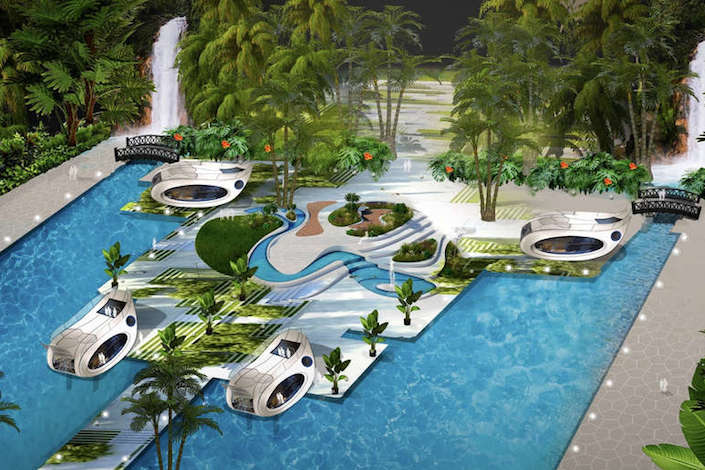Where travel agents earn, learn and save!
News / Hotel of Tomorrow Project unveils seven new hospitality concepts
So, what might travelers expect in the future?

Source: The Gettys Group
What will hotels of the future look like and how will they function? The Hotel of Tomorrow Project (HOT Project®), a global think tank of industry leaders, seeks to answer that question. After an eight-month collaborative effort, which included regular and virtual reality meet-ups on a custom-built HOT airship in the metaverse, a team of more than 200 including representatives from Hilton, IHG and Marriott hotels, along with technology experts and hospitality school students has unveiled seven future hotel visions.
The Hotel of Tomorrow® Project’s hospitality professionals, technology experts and product developers focused on the most pressing issues affecting their future: automation, personalization, modularity, sustainability, visualization, wellness and community. A new generation of future hoteliers also contributed to the project by participating in the HOT Ed™ Challenge, a global design competition among students at leading universities. More than eight hundred ideas were generated through facilitated workshops, seven of which are being shared with the public.
So, what might travelers expect in the future?
Robotic Reset. A changeable guest room that integrates automated, retractable, and revealable furnishings, as well as robot-delivered elements to suit changing guest needs. Smart furnishings incorporated in walls, floors and ceilings allows guest to exercise, dine, rest and work in the same room. Beds rise into the ceiling providing room for exercise equipment delivered by a robot and lounge seating emerges from the floor to accommodate socializing. The result: more efficient use of space and a dynamic living environment aided by automation. (image link below)
Sense & Satisfy Suite. The ultimate in hospitality personalization, this guest suite anticipates each occupants needs. Bio sensors throughout the room monitor a guest’s wellness, interaction and communicate via voice and holography. An anti-gravity sleep and mindfulness chamber monitors vital signs while making ambient adjustments including light, audio, temperature, and air quality. A holographic pet is available for the restless child who needs a companion, and an integrated smart-window, smart phone supports conversation and entertainment through A.I sorted data. Meal options are determined by dietary needs sensed by waste analysis. The result: a personalized guest experience that serves and addresses each guest’s needs, allowing them to depart more well than they arrived. (image link below)
Rebuildable Buildings. A mechanized meeting room built with modular and mobile components can be assembled and reassembled via robotic automation. Programmed in advance, the stage, tables, and banquet chairs self-configure and self-locate. A modular chandelier can be programmed to assume a variety of shapes and create myriad visual effects. Holographic table monitors convey screen data from the stage to the viewer and robots are available to reconfigure modular flooring and even set tables. The result: a highly flexible ballroom/meeting space, reset by automation utilizing modular components that can reduce and reuse waste. (image link below)
Restorative Resort. The functionality of under-utilized pool areas is transformed with the introduction of self-contained, mini-lodging units. Keyed to the popularity of “glamping,” these mobile, prefabricated units provide a private retreat for two or even a small group. Powered by solar energy and cooled and heated by geothermal technology, they offer a biophilic environment in an often under used section of a resort. The result: a new guest experience that capitalizes on indoor/outdoor spaces for retreat and restoration. (image link below)
A(R) World in Plain Site. An augmented reality overlay accessed through any smart device, this data-driven system enhances the guest experience by providing self-selected information, from message boards, weather, and air quality updates to hotel activity updates. This information is available in the guest’s chosen language and legibility scale. The result: an entire layer of real-time and purposeful information available to guests through their own devices. (image link below)
Energy Center Hotel. This building model anticipates advances in localized energy collection, storage, and distribution. The skin of the building features a flexible, translucent, photovoltaic skin that absorbs solar energy, which is stored in the structure’s basement and distributed to neighboring buildings. This multi-purpose/multi-use building (hotel + other) utilizes its virtual model (created for design and construction) as a real-time digital twin to track and display information about the actual building performance. The result: a hotel building created to better serve its community, including energy supply. (image link below)
The seventh concept – SpaX– is the winning entry of the HOT Ed™ Challenge, devised by a team from Haaga-Helia University of Applied Sciences, Helsinki, Finland. Targeting underutilized hotel spaces, SpaX taps into Finnish culture and tradition to create an immersive and healthful experience: forest bathing, ice swimming, and more. Envisioned as a sanctuary within a busy city hotel, SpaX combines the traditions of ancient healing with technology-enhanced multi-sensory components in a restful environment tailored to meet the needs of stressed travelers.
For more information on the Hotel of Tomorrow project go to hotel-of-tomorrow.com.











